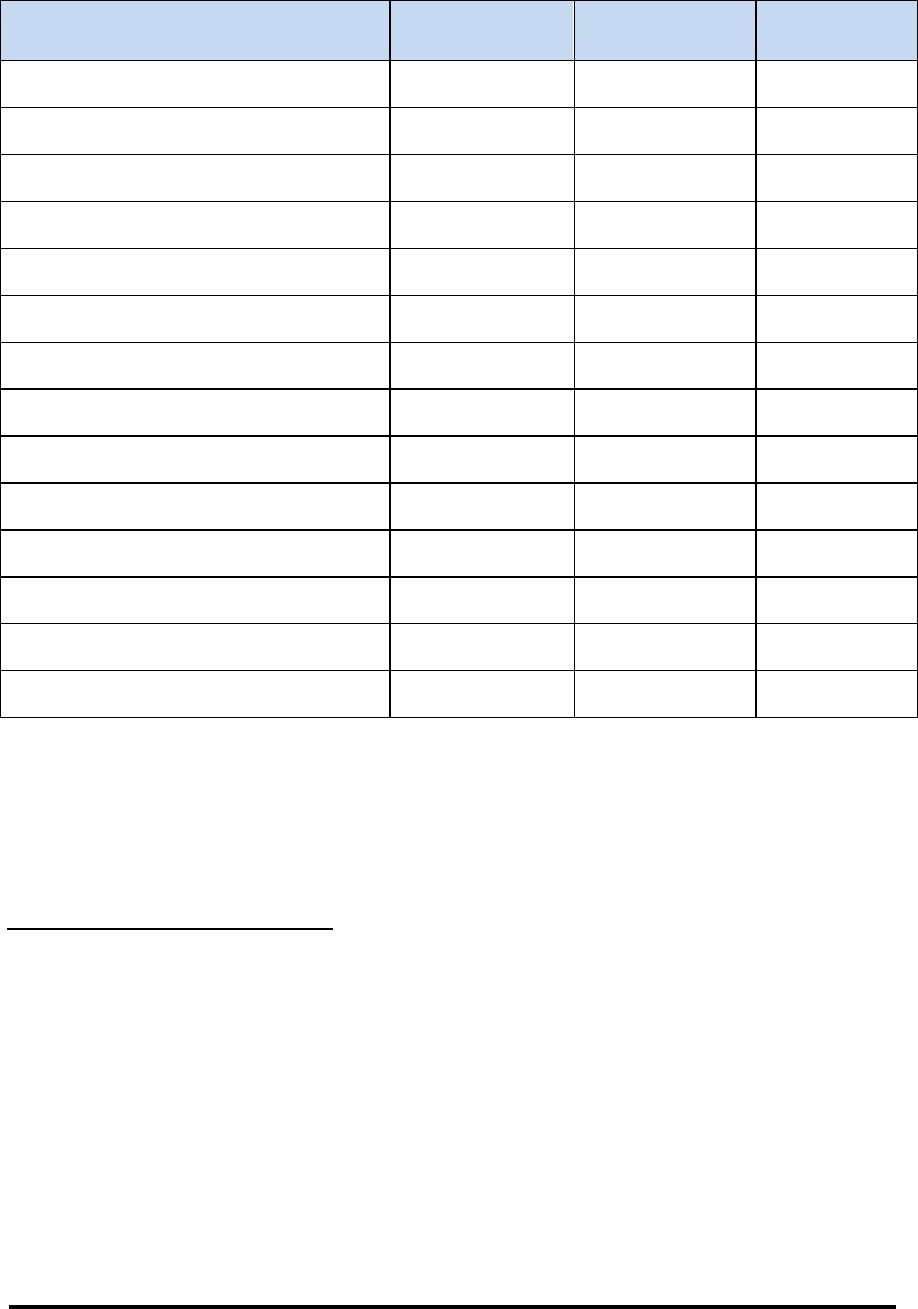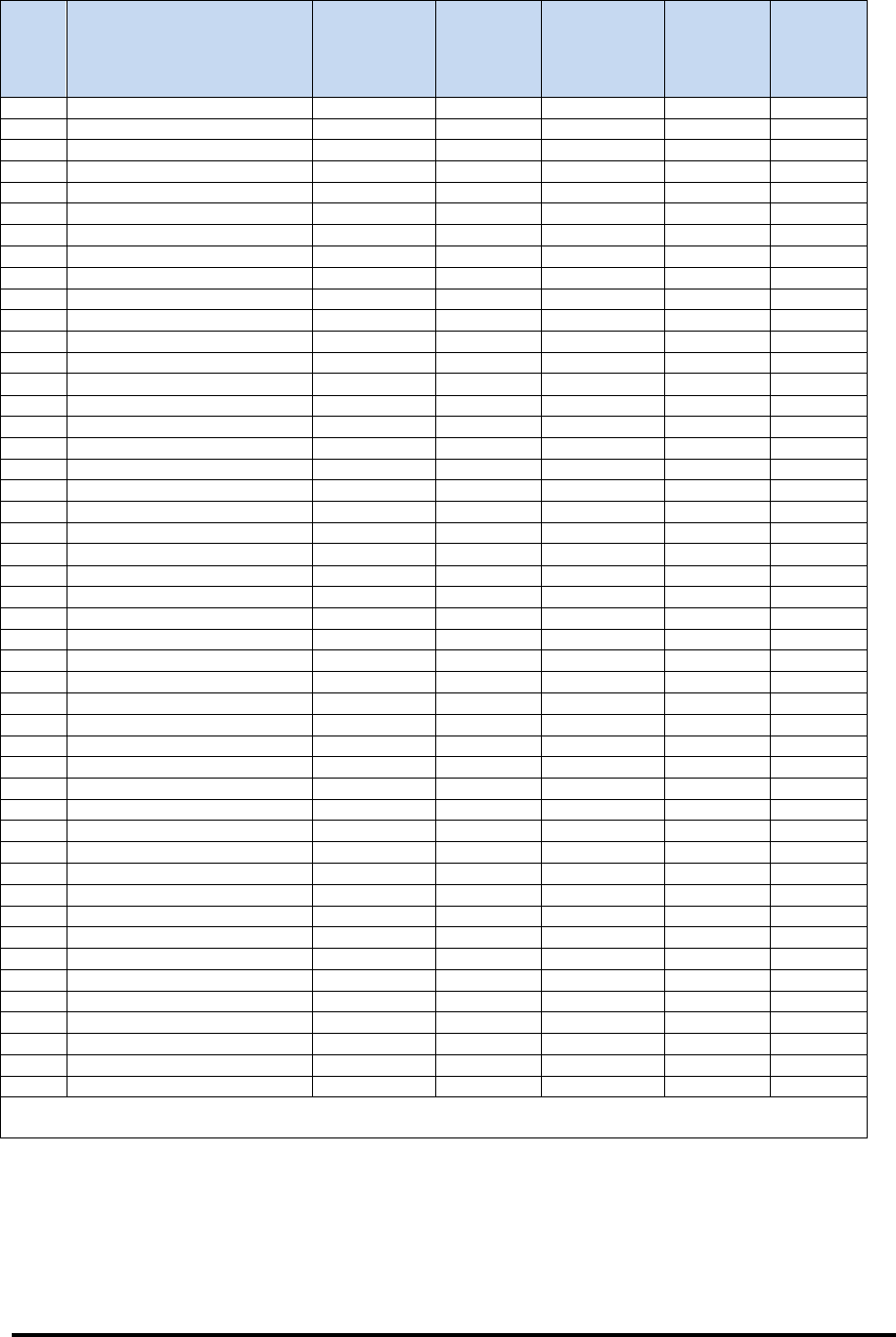Radwin RW5XMOD RF module operating in the 4.9-5.8 GHz Band User Manual Manual r1
Radwin Ltd. RF module operating in the 4.9-5.8 GHz Band Manual r1
Radwin >
Contents
- 1. Manual
- 2. Manual r1
- 3. User Manual
Manual r1

AP0127730, AP0134760
RF Module Operating in the 4.9-5.8 GHz bands
REFERENCE GUIDE

Regulatory Compliance
FCC/IC - Compliance
This equipment has been tested and found to comply with the limits for a Class B digital device,
pursuant to Part 15 of the FCC Rules and IC RSS standards. These limits are designed to provide
reasonable protection against harmful interference in a residential installation. This equipment
generates uses and can radiate radio frequency energy and, if not installed and used in
accordance with the instructions, may cause harmful interference to radio communications.
However, there is no guarantee that interference will not occur in a particular installation. If this
equipment does cause harmful interference to radio or television reception, which can be
determined by turning the equipment off and on, the user is encouraged to try to correct the
interference by one or more of the following measures:
• Reorient or relocate the receiving antenna.
• Increase the separation between the equipment and receiver.
• Connect the equipment into an outlet on a circuit different from that to which
the receiver is connected.
Consult the dealer or an experienced radio/TV technician for help.
Changes or modifications to this equipment not expressly approved by the party
responsible for compliance could void the user's authority to operate the equipment.
It is the responsibility of the installer to ensure that when using the outdoor
antenna kits, only those antennas certified with the product are used. The use
of any antenna other than those certified with the product is expressly
forbidden by FCC rules 47 CFR part 15.204 and IC RSS standards.
Il est de la responsabilité de l'installateur de s'assurer que lorsque vous
utilisez les kits d'antennes extérieures, seules les antennes certifiés avec le
produit sont utilisés. L'utilisation d'une antenne autre que ceux qui sont
certifiés avec le produit est expressément interdite par la réglementation FCC
partie 47 CFR 15.204 et IC normes RSS.
Outdoor units and antennas should be installed ONLY by experienced
installation professionals who are familiar with local building and safety codes
and, wherever applicable, are licensed by the appropriate government
regulatory authorities. Failure to do so may void the product warranty and
may expose the end user or the service provider to legal and financial
Caution liabilities. Resellers or distributors of this equipment are not liable for injury,
damage or violation of regulations associated with the installation of outdoor
units or antennas. The installer should configure the output power level of
antennas according to country regulations and antenna type.
AP0127730, AP0134760 Reference Guide i
Warning
Avertissement

Les unités extérieures et les antennes doivent être installés que par des
professionnels expérimentés d'installation qui sont familiers avec les normes
locales et les codes de sécurité et, si applicable, sont agréées par les autorités
gouvernementales de réglementation compétents. Ne pas le faire peut annuler
la garantie du produit et peuvent exposer l'utilisateur final ou le fournisseur de
services d'obligations juridiques et financiers.
Revendeurs ou distributeurs de ces équipements ne sont pas responsables des
blessures, des dommages ou violation des règlements liés à l'installation des
unités extérieures ou des antennes. L'installateur doit configurer le niveau de
puissance de sortie des antennes conformément aux réglementations
nationales et le type d'antenne.
This equipment should be installed and operated with a minimum distance of
354cm between
the radiator and your body.
Warning
Cet équipement doit être installé et utilisé à une distance minimale de 354cm
entre le radiateur et votre corps.
The module is granted to operate under FCC certification in the 4.9 GHz
and 5.8 GHz bands only.
Warning
This device complies with Part 15 of the FCC rules and with Industry Canada license-
exempt RSS standard(s). Operation is subject to the following two conditions:
(1) This device may not cause harmful interference.
(2) This device must accept any interference received, including interference that may
cause undesired operation.
Cet appareil est conforme la norme d'Industrie Canada exempts de licence RSS (s). Son
fonctionnement est soumis aux deux conditions suivantes:
1. Cet appareil ne peut pas causer d'interférences, et
2. Cet appareil doit accepter toute interférence, y compris les interférences qui peuvent
causer un mauvais fonctionnement de l'appareil.
This Class B digital apparatus complies with Canadian ICES-003.
Cet appareil numrique de la classe B est conforme la norme NMB-003 du Canada
AP0127730, AP0134760 Reference Guide ii
Prudence
Avertissement
Warning
Devices subject to RSS-210 Annex 9 shall not be capable of transmitting in
the band 5600-5650 MHz.

Overview
The AP0127730, AP0134760 is an RF module operating in the 4.9 – 5.8 GHz frequency
bands. It is a TDD OFDM radio supporting 5 MHz, 10 MHz, 20 MHz and 40 MHz channel
bandwidths.
The RF module cannot work as a stand-alone device. It can operate and be controlled only
when attached to a digital main board and altogether assembled in an enclosure suitable for
outdoor use. The assembly of the RF module attached to the digital main board is hereafter
referred to as ‘ODU’. The ODU in its various outdoor enclosures is manufactured by
RADWIN.
The RF module is certified as a limited modular approval type with the FCC ID:
Q3KRW5XMOD and IC: 5100A-RW5XMOD.
Condition of Use
The AP0127730, AP0134760 RF module is a proprietary radio interface and can only be
connected to digital boards manufactured by RADWIN. The ODU resides in an outdoor
enclosure also manufactured and assembled by RADWIN or its subcontractors. The RF
module is not for sale to the general public.
FCC rules and IC Regulation Restrictions
The ODU firmware is factory programmed to operate under the FCC rules and Industry
Canada regulation restrictions. The firmware is locked and inaccessible by any third party. As
a result of the above the user interface allows both the installer and the user to control the
ODU only within the boundaries of the regional restrictions.
Antennas
The AP0127730, AP0134760 RF module is certified with various antenna types covering both
Point-to-Point and Point-to-Multipoint systems up to 32 dBi gain.
AP0127730, AP0134760 Reference Guide 1

Certified Antennas
Following is the list of antennas certified for use with the AP0127730, AP0134760 RF
module:
Antenna Type
Manufacturer
Model Number
Antenna Max
Gain (dBi)
Sector Dual Pole Integrated 120 Deg
RADWIN Ltd.
MT0128930
11
Sector Dual Pole 120 Deg
RADWIN Ltd.
RW-9061-5004
11
Sector Dual Pole Integrated 95 Deg
RADWIN Ltd.
AM0135060
12
Sector Dual Pole 90 Deg
RADWIN Ltd.
RW-9061-5001
14
Sector Dual Pole 60 Deg
RADWIN Ltd.
RW-9061-5002
16.5
Sector Dual Pole Integrated 90 Deg
RADWIN Ltd.
MT0125250
13
Flat Panel Dual Pole Integrated
RADWIN Ltd.
AM0119960
16
Flat Panel Dual Pole Integrated
RADWIN Ltd.
AM0111760
16.5
Flat Panel Dual Pole Integrated
RADWIN Ltd.
MT0070760
24
Flat Panel Dual Pole External
RADWIN Ltd.
RW-9612-5001
23
Flat Panel Dual Pole External
RADWIN Ltd.
RW-9622-5001
29
Dual Pole Dish
RADWIN Ltd.
RW-9721-5158
29
Dual Pole Dish
RADWIN Ltd.
RW-9732-4958*
32
Shark Fin Monopole
RADWIN Ltd.
RW-9401-5002
12.5
* Not applicable for 4.9 GHz band
Maximum Output Power
5725 – 5850 MHz band - FCC/IC
The maximum output power can be set as follows, when operating in the 5.8 GHz band,
under FCC and IC regulations. The power values are for PtP systems and PtMP systems with
0 to 6 dBi total antenna assembly gain. For PtMP systems the total EIRP is limited to 36
dBm. Therefore the output power of these systems, using higher than 6 dBi total antenna
assembly gains will be reduced to comply with 36 dBm EIRP.
The highest conducted output power shall be limited to 30 dBm in all channel bandwidths
AP0127730, AP0134760 Reference Guide 2

4940 – 4990 MHz band - FCC/IC
The maximum output power can be set as follows, when operating in the 4.9 GHz band,
under FCC and IC. The power values shown below are for systems using 0 to 26 dBi total
antenna assembly gain. Systems using 29 dBi antenna gain must reduce output power by 3
dB.
5 MHz: 25.0 dBm
10 MHz: 23.0 dBm
20 MHz: 24.0 dBm
5250 – 5350 MHz band – FCC/IC
The maximum output power can be set as follows, when operating in the 5.2 GHz band,
under IC regulations. The total EIRP limit is 30 dBm. The power values are for systems with
0 to 6 dBi total antenna assembly gain. For systems using higher than 6 dBi total assembly
gain antennas the output power will be reduced to comply with 30 dBm EIRP.
5 MHz: 18.0 dBm
10 MHz: 20.0 dBm
20 MHz: 23.0 dBm
40 MHz: 24.0 dBm
5470 – 5725 MHz band – FCC/IC
The maximum output power can be set as follows, when operating in the 5.4 GHz band,
under IC regulations. The total EIRP limit is 30 dBm. The power values are for systems with
0 to 6 dBi total antenna assembly gain. For systems using higher than 6 dBi total assembly
gain antennas the output power will be reduced to comply with 30 dBm EIRP.
5 MHz: 17.0 dBm
10 MHz: 20.0 dBm
20 MHz: 23.0 dBm
40 MHz: 24.0 dBm
5150 – 5250 MHz band – FCC
The maximum output power can be set as follows when transmitting in the 5.1 GHz band,
under FCC regulations.
The total EIRP limit for PtP applications is 53 dBm.
The total EIRP limit for PtMP applications is 36 dBm.
The total EIRP limit for PtMP applications when transmitting at elevations above 30° relative
to the horizon is 21 dBm.
5 MHz: 24.0 dBm
10 MHz: 27.0 dBm
20 MHz: 28.0 dBm
40 MHz: 23.0 dBm
AP0127730, AP0134760 Reference Guide 3

US - OPERATION TO AVOID INTERFERENCE WITH TDWR
The US FCC, NTIA, FAA, and industry are working to resolve interference to Terminal Doppler Weather Radar
(TDWR) systems used near airports that has occurred from some outdoor wireless systems operating in the
5470 MHz – 5725 MHz band. These wireless devices are subject to Section 15.407. When operating as a
master device they are required to implement radar detection and DFS functions and radios must not transmit
on channels which overlap the 5600-5650 MHz band used by TDWR.
Additional information is available from
the FCC’s Knowledge Database (KDB) Publication 443999 “Interim Plans to Approve UNII Devices
Operating in the 5470-5725 MHz Band with Radar Detection and DFS Capabilities” available at
https://fjallfoss.fcc.gov/kdb/GetAttachment.html?id=33781
the Wireless Internet Service Providers Association (WISPA) in coordination with Spectrum Bridge:
http://www.spectrumbridge.com/udia/home.aspx. 5.4-GHz radios must be professionally installed.
The professional installer must have the following expertise:
Understanding of the configurations outlined in Table 2: US FCC IDs and Industry Canada Certification
Numbers and covered configurations, especially those applicable to the 5470-5725 MHz U-NII band.
Understanding of the master/slave operation of the RADWIN 2000, RADWIN 5000 and RADWIN 6000
family products into which the RF Module AP0127730 or AP0134760 is assembled (hereafter: ODU).
The Master ODU determines the operating frequency of the radio link (Master and Slave).
Understanding of the devices frequency-scan selection settings and how they can be set to prevent
scanning and therefore transmission on any specific frequencies.
Understanding of the option to set primary and two alternate frequencies on the Master ODU.
Ability to use the RADWIN Manager (hereafter: NMS) to set the primary and alternate transmit
frequencies on the Master ODU, scanned frequencies on an Slave ODU, and Transmit Output Power
of a radio.
Ability to use the NMS Spectrum View utility feature to observe the local RF environment.
Ability to determine if a radio is within 35 km (21.75 mi) of any Terminal Doppler Weather Radar
(TDWR) using the Search function available at http://www.spectrumbridge.com/udia/search.aspx, or
using various mapping programs and the data from in Table 1: TDWR Location Information.
Ability to set the Master ODU's transmit frequency (frequencies, if using alternate frequencies) and
Slave ODU's scanned frequencies at least 30 MHz (center-to-center) from any TDWR operating
frequency or frequencies within 35 km of the radio.
To gain this expertise the following training is required:
Study of the documentation
Familiarization in a lab or test environment
Hands-on training with an experienced installer.
Procedure 1 provides the specific instructions to avoid interfering with TDWR when using 5.4GHz ODUs
Procedure 1: Avoiding interference with Terminal Doppler Weather Radar (TDWR)
1. Use standard installation procedures with the additional steps outlined below.
2. For each 5.4-GHz ODU, determine if it is within 35 km (21.75 mi) of any Terminal Doppler Weather Radar
(TDWR). This can be done using the map search tool at http://www.spectrumbridge.com/udia/search.aspx, or
other mapping tools using the data from Table 1.
AP0127730, AP0134760 Reference Guide 4

4. If a Master ODU is within 35 km (21.75 mi) of any TDWR, disable the primary transmit frequency (and
alternate frequencies, if used) that are between 5570-5680 MHz.
5. If a Slave ODU is within 35 km (21.75) mi of any TDWR
Ensure its Master ODU isn’t using primary or alternate (if used) transmit frequencies that are within
5570-5680 MHz frequency range
Set the Slave ODU’s scanned frequencies to not include frequencies within 5570-5680 MHz frequency
range
Note, even if the Master ODU itself is more than 35 km from the TDWR, if any of its Slave ODUs are within 35
km, it must not operate within 5570-5680 MHz frequency range.
Note, in some instances an ODU may be within 35 km of multiple TDWRs. In this case, the device must not use
any frequency within 5570-5680 MHz frequency range.
6. Register each 5.4-GHz device operating within 35 km (21.75 mi) of any TDWR in the voluntary WISPA-
sponsored database at http://www.spectrumbridge.com/udia/home.aspx.
Note, this database may help expedite resolution of any interference to TDWRs.
7. Registration includes, at a minimum, Latitude, Longitude, and External Antenna Model. When registering a
device, choose whether to allow General Access or to have the device information viewable only by you and
government representatives.
AP0127730, AP0134760 Reference Guide 5

Table 1: TDWR Location Information
State
City
Longitude
Latitude
Frequency
Terrain
Elevation
(MSL) (ft)
Antenna
Height
above
Terrain
(ft)
AZ
PHOENIX
W 112 09 46
N 33 25 14
5610 MHz
1024
64
CO
DENVER
W 104 31 35
N 39 43 39
5615 MHz
5643
64
FL
FT LAUDERDALE
W 080 20 39
N 26 08 36
5645 MHz
7
113
FL
MIAMI
W 080 29 28
N 25 45 27
5605 MHz
10
113
FL
ORLANDO
W 081 19 33
N 28 20 37
5640 MHz
72
97
FL
TAMPA
W 082 31 04
N 27 51 35
5620 MHz
14
80
FL
WEST PALM BEACH
W 080 16 23
N 26 41 17
5615 MHz
20
113
GA
ATLANTA
W 084 15 44
N 33 38 48
5615 MHz
962
113
IL
MCCOOK
W 087 51 31
N 41 47 50
5615 MHz
646
97
IL
CRESTWOOD
W 087 43 47
N 41 39 05
5645 MHz
663
113
IN
INDIANAPOLIS
W 086 26 08
N 39 38 14
5605 MHz
751
97
KS
WICHITA
W 097 26 13
N 37 30 26
5603 MHz
1270
80
KY
COVINGTON CINCINNATI
W 084 34 48
N 38 53 53
5610 MHz
942
97
KY
LOUISVILLE
W 085 36 38
N 38 02 45
5646 MHz
617
113
LA
NEW ORLEANS
W 090 24 11
N 30 01 18
5645 MHz
2
97
MA
BOSTON
W 070 56 01
N 42 09 30
5610 MHz
151
113
MD
BRANDYWINE
W 076 50 42
N 38 41 43
5635 MHz
233
113
MD
BENFIELD
W 076 37 48
N 39 05 23
5645 MHz
184
113
MD
CLINTON
W 076 57 43
N 38 45 32
5615 MHz
249
97
MI
DETROIT
W 083 30 54
N 42 06 40
5615 MHz
656
113
MN
MINNEAPOLIS
W 092 55 58
N 44 52 17
5610 MHz
1040
80
MO
KANSAS CITY
W 094 44 31
N 39 29 55
5605 MHz
1040
64
MO
SAINT LOUIS
W 090 29 21
N 38 48 20
5610 MHz
551
97
MS
DESOTO COUNTY
W 089 59 33
N 34 53 45
5610 MHz
371
113
NC
CHARLOTTE
W 080 53 06
N 35 20 14
5608 MHz
757
113
NC
RALEIGH DURHAM
W 078 41 50
N 36 00 07
5647 MHz
400
113
NJ
WOODBRIDGE
W 074 16 13
N 40 35 37
5620 MHz
19
113
NJ
PENNSAUKEN
W 075 04 12
N 39 56 57
5610 MHz
39
113
NV
LAS VEGAS
W 115 00 26
N 36 08 37
5645 MHz
1995
64
NY
FLOYD BENNETT FIELD
W 073 52 49
N 40 35 20
5647 MHz
8
97
OH
DAYTON
W 084 07 23
N 40 01 19
5640 MHz
922
97
OH
CLEVELAND
W 082 00 28
N 41 17 23
5645 MHz
817
113
OH
COLUMBUS
W 082 42 55
N 40 00 20
5605 MHz
1037
113
OK
AERO. CTR TDWR #1
W 097 37 31
N 35 24 19
5610 MHz
1285
80
OK
AERO. CTR TDWR #2
W 097 37 43
N 35 23 34
5620 MHz
1293
97
OK
TULSA
W 095 49 34
N 36 04 14
5605 MHz
712
113
OK
OKLAHOMA CITY
W 097 30 36
N 35 16 34
5603 MHz
1195
64
PA
HANOVER
W 080 29 10
N 40 30 05
5615 MHz
1266
113
PR
SAN JUAN
W 066 10 46
N 18 28 26
5610 MHz
59
113
TN
NASHVILLE
W 086 39 42
N 35 58 47
5605 MHz
722
97
TX
HOUSTON INTERCONTL
W 095 34 01
N 30 03 54
5605 MHz
154
97
TX
PEARLAND
W 095 14 30
N 29 30 59
5645 MHz
36
80
TX
DALLAS LOVE FIELD
W 096 58 06
N 32 55 33
5608 MHz
541
80
TX
LEWISVILLE DFW
W 096 55 05
N 33 03 53
5640 MHz
554
31
UT
SALT LAKE CITY
W 111 55 47
N 40 58 02
5610 MHz
4219
80
VA
LEESBURG
W 077 31 46
N 39 05 02
5605 MHz
361
113
WI
MILWAUKEE
W 088 02 47
N 42 49 10
5603 MHz
820
113
Latitude and Longitude are specified in NAD 83 Last updated July 30, 2010
AP0127730, AP0134760 Reference Guide 6

Table 2: US FCC IDs and Industry Canada Certification Numbers and covered configurations1, 2
1. The table is relevant for all ODUs belonging to RADWIN 2000, RADWIN 5000 and RADWIN
6000 family products into which the RF Module AP0127730 or AP0134760 is assembled.
2. Under FCC ID: Q3KRW5XMOD, IC: 5100A-RW5XMOD
3. Excluding 5600-5650 MHz band
Radio parameters accessed by end-user
The following parameters can be accessed by user:
1. Output Power
2. Frequency channel
3. Channel bandwidth
4. Antenna gain in external antenna type device
AP0127730, AP0134760 Reference Guide 7
Channel BW
[MHz]
Center Freq. Range
[MHz]
5
5255 - 5345
10
5260 - 5340
20
5265 - 5335
40
5275 - 5320
5
5475 - 57203
10
5475 - 57203
20
5480 - 57153
40
5500 - 56953
5
5727.5 - 5847.5
10
5730 - 5845
20
5735 - 5840
40
5745 - 5830
5
4942.5 – 4987.5
10
4945 – 4985
20
4950 - 4980
5
5157 - 5245
10
5162 – 5245
20
5165 – 5240
40
5172 - 5230